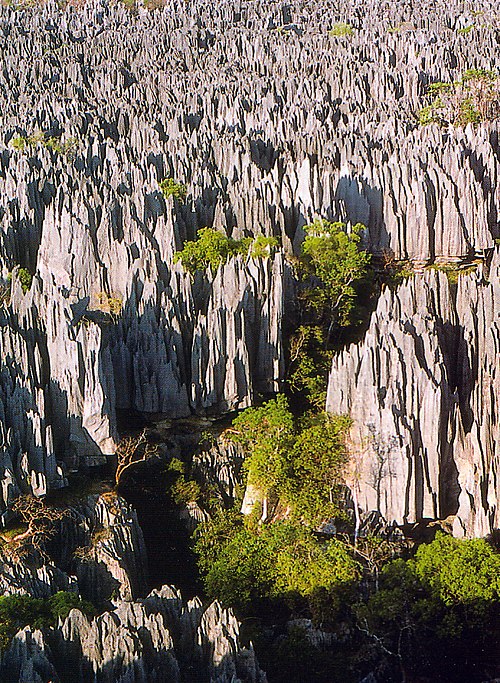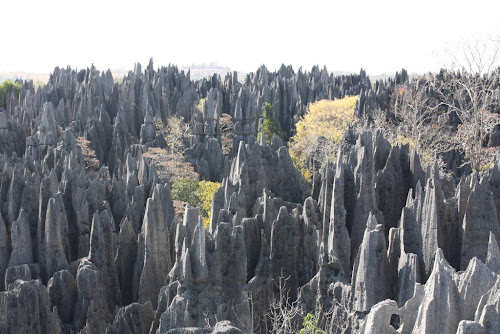'Tsingy de Bemaraha Strict Nature Reserve' in Western Madagascar is
a unique region of amazingly jagged landscape, where needle-shaped
limestone formations known as 'Tsingy' rise to heights ranging from few metres to several hundred
metres. The razor-sharp karst pinnacles were created due to erosion of limestone
cliff by heavy tropical rain. Spread over an area of about 600 Sq. Kms. (230 Sq.
miles) along the River Manambolo, it is considered to be World's largest
stone forest.
As per National Geographic (Nov. 2009);
"The unusual formations here are a type of karst system, a landscape formed from porous limestone that was dissolved, scoured, and shaped by water. The exact processes that carved such an otherworldly stonescape are complex and rare; only a few similar karst formations exist outside Madagascar. Researchers believe that groundwater infiltrated the great limestone beds and began to dissolve them along joints and faults, creating caves and tunnels. The cavities grew, and eventually their roofs collapsed along the same joints, creating line-straight canyons called grikes, up to 400 feet deep and edged by spires of standing rock. Some grikes are so tight that a human traveler has difficulty passing through them; others are as wide as an avenue."
"The unusual formations here are a type of karst system, a landscape formed from porous limestone that was dissolved, scoured, and shaped by water. The exact processes that carved such an otherworldly stonescape are complex and rare; only a few similar karst formations exist outside Madagascar. Researchers believe that groundwater infiltrated the great limestone beds and began to dissolve them along joints and faults, creating caves and tunnels. The cavities grew, and eventually their roofs collapsed along the same joints, creating line-straight canyons called grikes, up to 400 feet deep and edged by spires of standing rock. Some grikes are so tight that a human traveler has difficulty passing through them; others are as wide as an avenue."
The 'Tsingy' which in English translates to 'where one cannot
walk' has remained largely unexplored and isolated from most of the World due to
these incredibly sharp limestone formations which can easily cut through shoes
and flesh. Some walkways and bridges have been provided over smaller pinnacles
(known as 'Petits Tsingy') for visitors. The larger pinnacles called 'Grand
Tsingy' are accessible only to climbers using ropes and climbing equipment.
Although the region is inhospitable for humans and most of the animals yet it is
home to 11 species of lemur, 100 types of bird and 45 kinds of reptile.
The area is listed as a
UNESCO World Heritage Site.

Image from Wikimedia Commons is by Moq
Image from Panoramio is by Stéphane Sagon

Image from Wikimedia Commons is by Gloumouth1

Image from Picasa Web is by rena.remy

Image from Wikimedia Commons is by Zigomar
View general location in Google Earth / Google Maps
Source of info and more info:
- National Geographic November 2009 - Living on a Razor's Edge
- Daily Mail Online - Life on the edge: Inside the world's largest STONE forest.. (Contains some great images)
- Wikipedia

No comments:
Post a Comment
Please feel free to write your comments but remember that the same are moderated. So please do not post SPAM comments i.e. your business links here including surrogate links.
Comments containing SPAM are liable for rejection.